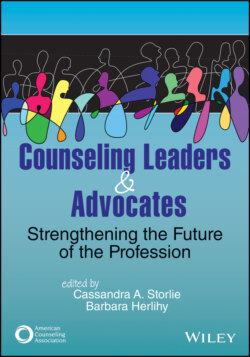Читать книгу Counseling Leaders and Advocates - Группа авторов - Страница 48
Leadership and Advocacy in the Schools and General Higher Education
ОглавлениеAs schools have increased their accountability for student academic performance, greater pressure has been placed on teachers and administrators to ensure that state testing scores and graduation rates are at optimum levels (Hines et al., 2020; Wright, 2012). Given this context, comprehensive school counseling programs are more important than ever, particularly as school counselors seek to close the achievement gap and when schools fall below performance standards. Turnaround schools, or those with consistently low academic performance (20% or more falling below state minimums), often require overhauls in leadership, staffing, practices, and school culture (Hines et al., 2020). School counselors with expertise in data analysis as well as programming in the social/personal, academic, and career needs of students play an essential transformative role in these schools, aiding students in removing systemic barriers that impede their success (Hines et al., 2020). School counselors, collaborating with teachers, administrators, students, parents, and other stakeholders, garner additional resources to support students as they identify policies and practices that can be changed to improve student outcomes.
When students were learning in school buildings (before the coronavirus pandemic), teachers and administrators may have noticed increased behavioral concerns that appeared to be “disruptive” and counterproductive to the academic aims of the school. What they may not have realized is that students could be presenting symptoms of adverse childhood experiences (ACEs), most notably, trauma. School counselors can use attendance, passing rates, and behavior data to better understand potential symptoms of trauma (Howell et al., 2019). Furthermore, they may lead training and policy changes to implement trauma-informed approaches that support student and teacher self-care and wellness practices that coincide with other healthy behaviors (Howell et al., 2019; Martin et al., 2017).
School counselors faced new challenges as a result of the coronavirus pandemic. Distance learning became a primary teaching modality when 50.8 million public school students were affected by K–12 school closures during the pandemic (Maxwell, 2020). As a result, school counselors needed to connect with students in a virtual environment—that is, if students had access to the internet and had a tablet or computer with which to communicate. School counselor roles also changed during the pandemic, and many found themselves being a primary support not only for students but also for parents and school personnel (Meyers, 2020b).
For school counselors to be effective in leadership and advocacy efforts, they often must advocate for themselves, clarifying their roles and skills. Administrators may lack awareness of the capabilities of school counselors and their full potential to implement effective programming that can affect academic outcomes (Fye et al., 2018; Hines et al., 2020). This may be especially true in turnaround schools, where immediate crisis demands present an urgency that may pull school counselors out of the role they were trained to fulfill. Professional advocacy is paramount, and having a strong relationship with the school principal can be key (Beck & Lane, 2019). In fact, forging such a relationship was a top concern in the advocacy work of 2019 finalists for the ASCA School Counselor of the Year Award (Beck & Lane, 2019).
School counselors may review the ASCA Legislative Issues web page (https://www.schoolcounselor.org/About-School-Counseling/Legislative-Issues) for more information about advocacy issues that are of great concern to the profession. Two current issues are the need to reduce staffing ratios for school counselors and related personnel and promoting school safety. The Elementary and Secondary School Counseling Act, proposed in 2019 and pending approval as of this writing, provides grant funding of no less than $1 million per state to fund additional school counselors, particularly in high need areas. School safety has become a concern both in terms of gun violence and in the recent coronavirus pandemic. Many perspectives exist on how to address gun violence, but ASCA strongly opposes the diversion of funding allocated for academic achievement and student learning toward efforts to arm educators (ASCA, 2018). In 2020, the coronavirus pandemic raised new concerns about safety and health for students and teachers alike. Students are faced with new challenges to their academic performance due to remote learning and social isolation from their peers. All of these are concerns at the school and district levels, and public officials and administrators are making budget decisions to cut or fund specific personnel as well as setting policies related to school safety.
College counselors serving transitional-aged youth (18–25) may have similar concerns as universities and community colleges try to keep up with demand for mental health services. The Center for Collegiate Mental Health (2016) found that the 29.6% increase in students seeking counseling services nationwide far exceeded the 5.6% increase in student enrollment. They also noted that the demand appeared to result from higher levels of distress reported by these students, particularly anxiety and depression. Counselor advocacy can address these staffing shortfalls while also addressing the sources of student distress. Advocacy may be somewhat different based on the population and university structures, but the larger planning process could still apply (Trusty & Brown, 2005).
